The following is tested, but only so far as what the original question brought up (Test it more for me?), I wrote it using the provided XML example and by copying the code for the AddCreditCard code.
When you are all done updating the following code will work:
var cg = new CustomerGateway("login", "transkey", ServiceMode.Test);
var c = cg.CreateCustomer("peter@example.com", "test customer");
//just to show that we didn't break CC
cg.AddCreditCard(c.ProfileID, "cc#", 07, 2011);
cg.AddBankAccount(c.ProfileID, "Peter", "bankaccoung#", "routing#");
//tostring doesn't actually do much... but if you break on it you can see the details for both the CC and the bank info.
foreach (PaymentProfile pp in cg.GetCustomer(c.ProfileID).PaymentProfiles)
{
Console.WriteLine(pp.ToString());
}
First, download the C# source code for the API from http://developer.authorize.net/downloads/.
In reviewing the code I can see 4 files that use "creditCardType", these are SubscriptionRequest.cs, CustomerGateway.cs, PaymentProfile.cs and AnetApiSchema.cs (this last one we don't have to touch). We also need to watch out for 'creditCardMaskedType', which is used in PaymentProfile.cs, Transaction.cs and AnetApiSchema.cs. Any place these files show up we need to make sure we support the bankAccount equivelants as well.
Open the AuthorizeNET solution. We'll be jumping around a bit through the files listed above.
In CustomerGateway.cs add the following block of code:
/// <summary>
/// Adds a bank account profile to the user and returns the profile ID
/// </summary>
/// <returns></returns>
public string AddBankAccount(string profileID, string nameOnAccount, string accountNumber, string routingNumber)
{
var req = new createCustomerPaymentProfileRequest();
req.customerProfileId = profileID;
req.paymentProfile = new customerPaymentProfileType();
req.paymentProfile.payment = new paymentType();
bankAccountType new_bank = new bankAccountType();
new_bank.nameOnAccount = nameOnAccount;
new_bank.accountNumber = accountNumber;
new_bank.routingNumber = routingNumber;
req.paymentProfile.payment.Item = new_bank;
var response = (createCustomerPaymentProfileResponse)_gateway.Send(req);
return response.customerPaymentProfileId;
}
In PaymentProfile.cs add some public properties
public string BankNameOnAccount {get; set; }
public string BankAccountNumber { get; set; }
public string BankRoutingNumber { get; set; }
Modify the the following block of the PaymentProfile(customerPaymentProfileMaskedType apiType) constructor:
if (apiType.payment != null) {
if(apiType.payment.Item is bankAccountMaskedType) {
var bankAccount = (bankAccountMaskedType)apiType.payment.Item;
this.BankNameOnAccount = bankAccount.nameOnAccount;
this.BankAccountNumber = bankAccount.accountNumber;
this.BankRoutingNumber = bankAccount.routingNumber;
}
else if (apiType.payment.Item is creditCardMaskedType)
{
var card = (creditCardMaskedType)apiType.payment.Item;
this.CardType = card.cardType;
this.CardNumber = card.cardNumber;
this.CardExpiration = card.expirationDate;
}
}
Add this block to the PaymentProfile.ToAPI() method:
if (!string.IsNullOrEmpty(this.BankAccountNumber))
{
bankAccountType new_bank = new bankAccountType();
new_bank.nameOnAccount = BankNameOnAccount;
new_bank.accountNumber = BankAccountNumber;
new_bank.routingNumber = BankRoutingNumber;
result.payment.Item = new_bank;
}
Add the following public properties to SubscriptionRequest.cs > SubscriptionRequest class (around line 187)
public string BankNameOnAccount {get; set; }
public string BankAccountNumber { get; set; }
public string BankRoutingNumber { get; set; }
Add the following else if block TWICE to SubscriptionRequest. The first time is in the ToAPI method, the second is in the ToUpdateableAPI method, in both cases it goes after the CC number null check.
else if (!String.IsNullOrEmpty(this.BankAccountNumber))
{
bankAccountType new_bank = new bankAccountType();
new_bank.nameOnAccount = BankNameOnAccount;
new_bank.accountNumber = BankAccountNumber;
new_bank.routingNumber = BankRoutingNumber;
sub.payment = new paymentType();
sub.payment.Item = new_bank;
}
Add the following public properties to Transaction.cs
public string BankNameOnAccount { get; set; }
public string BankAccountNumber { get; set; }
public string BankRoutingNumber { get; set; }
In Transaction.cs in the static NewFromResponse(transactionDetailsType trans) method, find the block that checks for trans.payment != null and tweak as shown:
if (trans.payment != null) {
if (trans.payment.Item.GetType() == typeof(creditCardMaskedType))
{
var cc = (creditCardMaskedType)trans.payment.Item;
result.CardNumber = cc.cardNumber;
result.CardExpiration = cc.expirationDate;
result.CardType = cc.cardType;
}
else if (trans.payment.Item.GetType() == typeof(bankAccountMaskedType))
{
var bankAccount = (bankAccountMaskedType)trans.payment.Item;
result.BankNameOnAccount = bankAccount.nameOnAccount;
result.BankAccountNumber = bankAccount.accountNumber;
result.BankRoutingNumber = bankAccount.routingNumber;
}
}

